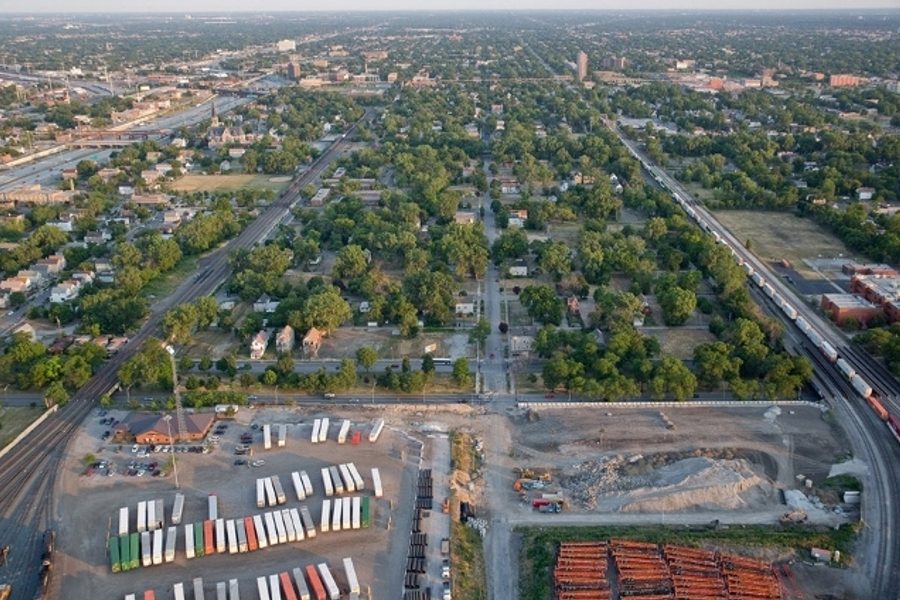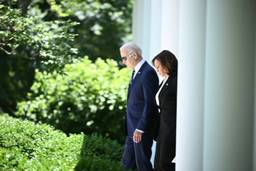
Residents of Chicago’s predominantly African-American community of Englewood are fighting Mayor Rahm Emanuel and Norfolk Southern (NS) — a major railroad corporation that posted $1.7 billion in profits last year—over a proposed freight yard expansion in their neighborhood that they argue will significantly increase diesel pollution, which is linked to asthma attacks, cancer and heart disease. Community activists say NS and the city have largely ignored their concerns.
Englewood residents first learned in late 2011 of the Emanuel-backed plan to expand NS’s existing 140-acre intermodal terminal at 47th Street — where trains and trucks swap freight containers — by an additional 84 acres. At the time, NS had been quietly buying up private properties in the area for about three years and had started bulldozing them. Only after the Resident Association of Greater Englewood (RAGE) exposed this apparent land grab and it became public knowledge that the company was in talks with the city to purchase 105 city-owned lots for the expansion was a public meeting finally convened with representatives of the railroad.
“[NS] came with guns,” says Asiaha Butler, president of RAGE. “They had armed security at a community meeting at a high school, as if they were going to be attacked.” She says this was only one example of a pattern of disrespect by the company toward the residents.
Rev. John Ellis, who lives near the planned expansion site, says he is particularly disgusted with the city. “[The city has] been terrible,” he says, citing the lack of proper notification given to the residents of the plan. “They feel they don’t have to notify anybody — ‘this is a black neighborhood so who the hell cares?’ I mean it, that’s basically what it is.”
Along with fellow resident John Paul Jones, Rev. Ellis helped found Sustainable Englewood Initiatives (SEI) last year, a nonprofit focused on mitigating the environmental and health risks posed by the freight yard expansion. SEI is not opposed to the project, but is seeking a fair deal for the community. “Economic growth is great, but it shouldn’t come at the expense of people’s health,” Ellis says.
Railroaded
Located on Chicago’s south side, Englewood has an unemployment rate of 21.3 percent and the community’s per capita annual income is just under $12,000. The population has plummeted from more than 97,000 in 1960 to about 30,000 today. Since Emanuel became mayor, a half-dozen public schools in and around Englewood have been closed. Last year there were 21 reported homicides in the community.
When the housing market collapsed in 2008, home prices in Englewood plummeted and the community saw one of the highest foreclosure rates in the city. Activists argue that NS took advantage of the situation to swoop in and buy up homes for as little as $25,000. The company stresses that houses were sold at “fair market value.”
“Relocation and replacement costs rather than fair market value would be a starting point because fair market value isn’t fair to anyone of color,” says Naomi Davis, president of Blacks In Green, an economic development organization supporting SEI. “If [NS] wanted to pay… to relocate people, they could certainly afford to do that.”
NS also points out that houses have been sold “voluntarily.” However, activists say people who refuse to sell to NS are in an impossible position, as their homes will end up as “islands” within the freight yard, surrounded by diesel pollution. “Even if you stay and the railroad stonewalls you, you’re poisoned out of your home,” says Davis. Residents who have refused to sell thus far fear the city will ultimately invoke eminent domain to force them out.
The residents’ concerns have been validated by a recent analysis from the Environmental Law and Policy Center (ELPC), a Chicago-based nonprofit. As reported in the Chicago Tribune last month, the ELPC, using a computer model created by the Environmental Protection Agency and inputting data provided by NS, found that diesel pollution from the planned expansion would increase air-borne soot to levels that would violate federal air quality standards, and expose several schools to dangerous levels of nitrogen dioxide emissions.
Diesel pollution is strongly associated with asthma attacks, and Englewood already has twice the hospitalization rate for asthma as the rest of the city. African Americans — who make up most of the Englewood community — are three times more likely to die from asthma than whites. Noting that asthma is deadlier than gang violence, Davis calls the expansion plan “gangbanging without a gun.”
A partnership, or a shell game?
The Englewood freight yard expansion project might never have been planned if not for federal funding (via President Obama’s 2009 stimulus bill) for rail improvements in metropolitan Chicago. The multibillion-dollar Chicago Region Environmental And Transportation Efficiency program (CREATE) — a public-private partnership between local, state and federal agencies and private railroad companies, including NS — was designed to be the long-sought solution to passenger and freight rail congestion in Chicago.
Among CREATE’s 70 projects are two — the Englewood Flyover and the Grand Crossing Rail Project—that will increase the movement of freight trains in and out of NS’s intermodal yard by providing additional track for Amtrak and Metra commuter trains, thereby reducing congestion. With the more efficient movement of goods that would come from these projects — both of which remain unfinished— NS had good reason to expand its freight yard in Englewood, according to Jean-Paul Thomas, a member of the Citizens Coalition on the Grand Crossing Railroad Project, a group trying to ensure a fair deal for residents affected by CREATE projects.
But Rev. Ellis says the public-private partnership amounts to a “shell game.” With CREATE, he argues, public entities like Metra, Amtrak, and the U.S., Illinois and Chicago Departments of Transportation that are seeking rail improvements can blame the private railroad companies for any problems caused by the improvements. NS plays the “hatchet man,” says Ellis, driving people out of their homes for land that will overlap with rail improvement projects, and public officials can tell concerned residents, “That’s not us, that’s Norfolk Southern.”
In March, under pressure from Emanuel, the Chicago City Council approved the sale of 105 city-owned lots in Englewood to NS for $1.1 million. A third of these parcels lie within two tax increment financing (TIF) districts. TIFs divert property tax revenues into a special fund meant for economic development within designated “blighted” areas, though as the Chicago Reader’s Ben Joravsky has long reported, TIF funds often wind up benefiting wealthy corporations and well-connected developers.
The rules governing the Englewood Neighborhood TIF and the 47th Street TIF — where 34 city-owned parcels acquired by NS are located — state that redevelopment within the TIF boundaries must be for residential or open-space purposes. To get around this requirement, Emanuel and the company want to simply amend the TIFs by reclassifying the land use from “residential” to “light industrial.” The fact that the land sale was brokered before the TIFs were amended is unusual, revealing the city’s haste and apparent disregard for procedure.
Community members worry the amendments will allow NS to receive TIF revenues for the intermodal expansion, but officials at the city’s Department of Housing and Economic Development (HED) insist this won’t happen. Activists are also pressing the city to extract concessions from NS before any amendments to the TIFs are passed — including measures to significantly reduce diesel pollution, develop green spaces, and ensure real economic opportunities for the residents. Alderman Willie Cochran — whose 20th Ward encompasses the area of the intermodal expansion — met with NS and HED regarding concessions, but residents say he didn’t consult them before recently reaching an agreement.
Community activists and supporters are calling for the railroad to install diesel pollution filters on all its equipment, which could reduce pollution by as much as 95 percent. In its agreement with Cochran, NS has promised it will upgrade its current fleet of hostler trucks in the yard to meet stringent “Tier 4” federal emissions standards within a decade. But community members are not satisfied, as the company has said nothing about its lift and loading equipment, nor has it taken into account the added equipment that will result from the expansion.
The city and NS are also promising 400 new permanent jobs, but residents are skeptical. “We’d like to have a list of all companies, job titles, locations and pay of these 400 permanent jobs,” says Davis. “We need to scrutinize these job numbers meticulously, because the devil…lives in those details.”
It is also questionable what kind of employer NS would be. Earlier this year, the Occupational Safety and Health Administration fined the company over $1 million for firing three employees as retaliation for reporting workplace injuries.
‘Not just a news blurb’
On August 15, the Chicago Plan Commission convened its monthly hearing at City Hall to vote on the TIF amendments. Alderman Cochran and two NS representatives joined John Molloy, economic development coordinator at HED, to endorse the proposal.
More than two dozen Englewood residents and allies wearing SEI T-shirts packed the gallery, half of who addressed the commission to express their opposition to the amendments. Each person was allowed three minutes to speak. Ellis reminded the commissioners, “We are a real community…not just a news blurb or a headline.”
Nancy Loeb, director of the Northwestern University Environmental Advocacy Center and attorney for SEI, told the commission that procedural requirements for amending the TIFs — including holding a public hearing and providing public notice — had been violated and could be the basis for a future legal challenge.
Saying he was “extremely disturbed,” Commissioner John Bryant motioned to postpone the vote for one month to allow time for the residents’ concerns to be addressed. “All across the country these entities have always [been] placed in poor communities that do not have the financial or the political oomph to stop them; they’re never taken to communities of strength and economic and political clout,” Bryant said.
Cochran walked out of the hearing as his constituents offered their comments, and Bryant noted his absence: “I don’t understand how the alderman could have left.” After 49th Ward Alderman Joe Moore also expressed “disappointment” that Cochran had stepped out, the alderman reappeared. Bryant asked him how many meetings had been held with the community.
“To give you a total number of meetings, I would not be able to,” Cochran replied. He insisted, “I am the advocate of my community,” a line which drew laughs from the gallery.
NS representative Herbert Smith downplayed the project’s health risks, telling the commissioners that the ELPC analysis reported in the Tribune had “flawed assumptions in its modeling method” and was “really good theater.”
Commissioner Leslie Bond shot back: “Just saying that their methodology was wrong is not enough for me.”
Bryant’s motion to defer the vote was swiftly carried. The gallery erupted in applause as Chairman Martin Cabrera banged a gavel, calling for “order.”
“From our perspective, the impossible happened. We were not supposed to succeed at all, not supposed to be able to do anything,” says Rev. Ellis. “The odds are still weighed against us, but, boy, things are happening.”
Jeff Schuhrke is a labor historian and assistant professor at the Harry Van Arsdale Jr. School of Labor Studies, SUNY Empire State University. He is the author of Blue-Collar Empire: The Untold Story of US Labor’s Global Anticommunist Crusade.




